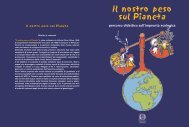Myanmar Protected Areas: Context, Current Status ... - Istituto Oikos
Myanmar Protected Areas: Context, Current Status ... - Istituto Oikos
Myanmar Protected Areas: Context, Current Status ... - Istituto Oikos
Create successful ePaper yourself
Turn your PDF publications into a flip-book with our unique Google optimized e-Paper software.
4.3 Conclusions and recommendations<br />
The study has achieved the objectives agreed among stakeholders.<br />
In-depth Study of Rakhine Yoma Elephant Range Wildlife Reserve<br />
A land cover map representing the different vegetation types covering the Rakhine Yoma Elephant Range<br />
Wildlife Reserve and the surrounding areas is now available. Local stakeholders have the possibility<br />
to use the maps and data produced during the present activity to conduct future activities and raise<br />
awareness on the problems threatening ecosystem and biodiversity in relation to the generation of a<br />
protected area.<br />
Overall, it seems that from the 1974 this remote protected area has not undergone major changes<br />
in terms of vegetation reduction and cannot be considered as a hot spot of degradation. Generally,<br />
human activities are reduced inside the Wildlife Sanctuary compared with the surrounding areas and<br />
the vegetation status seems to be better, even if it is subject to fragmentation mainly due to shifting<br />
cultivation. Moreover, due to the high impact of the human activities all around the border, also the<br />
protected area may be at risk for future encroachment due to agricultural expansion or commercial<br />
plantation.<br />
In this context it should be useful to quantify the human-pressure and potential future market which<br />
may determine uncontrolled change in the protected area.<br />
As well as the danger of encroachment, also the degradation of the remaining patches of forest owing<br />
to over-exploitation of timber, fires started by people and soil erosion seem to be a major concern. Many<br />
small landslides have been also detected on satellite images and during field survey, but they have not<br />
been quantified. Creation of a buffer zone, accessibility tracks, elephant inventory, spring and water<br />
points, should be evaluated in the future in order to generate a strategic and sustainable plan for the<br />
development of the PA.<br />
An interesting scientific point would be to evaluate the ecological/biological effect of the expansion<br />
of Melocanna bambusoides, and to understand how much human activity is enhancing this process.<br />
Also the impacts of this process on the wildlife could not been assessed in the present study, but they<br />
are nevertheless of critical importance and should be investigated in the future. For example, the<br />
population of wild elephants widely feeds on bamboos. At the same time, a population of Hoolock<br />
Gibbons (Bunopithecus hoolock) seems to be present in the southern fringes of the Rakhine Yoma, and<br />
for this monkey large patches of bamboo brakes are a barrier (Pers. comm., Gibbon Project from BANCA).<br />
Overall a reduction of greenness was found using the satellite images and, although some trends can be<br />
outlined, evergreen forests appear subject to degradation while bamboo formations increase in vigour.<br />
Conclusion<br />
144 145<br />
L. Beffasti<br />
5






